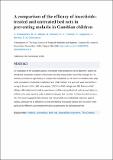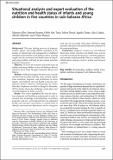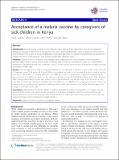Dietary Practices, Physical Activity, and Overnutrition Among School-Going Children Aged 8 - 11 Years in Thika Town, Kiambu County, Kenya
View/
Publication Date
2024-07Type
Thesis, Dissertationviews
downloads
Metadata
Show full item record
Abstract/
Introduction: Childhood overnutrition is a growing public health issue. It is a significant risk factor for non-communicable diseases and is becoming increasingly prevalent in low- and middle-income countries. This study aimed to determine the influence of dietary practices and physical activity levels on overnutrition among school-going children aged 8–11. Methods: A cross-sectional design with multistage sampling was employed. A total of 281 children were recruited from five schools. A food frequency questionnaire was used to assess dietary intake. Physical activity was evaluated using the physical activity questionnaire for older children. Body mass index (BMI for age and sex) z-score was used to indicate nutrition status. Univariate, bivariate, and multivariate analysis was applied to determine associations between the independent variables and overnutrition. Results: The median age of the respondents was 10 years, and over half (55%) were girls. Most (66.6%) of the children had adequate nutrition status, while 22.4% and 11% were underweight and overweight, respectively. There was a notably high frequency of consumption of foods from grains, plantains, white roots, and tubers (19.2%), as well as the deep-fried and salty (12%) food groups. About 11.7% of the children consumed caffeinated drinks. Nearly half (45.2%) of the children were inactive. Overnutrition was significantly higher among private than public school children (aOR 2.641; 95% CI = 1.013-6.887, p = 0.0047). There was a significantly higher prevalence of overnutrition amongst children who didn’t walk to school than those who walked, though it was not statistically significant (aOR 2.017; 95% CI = 0.875-4.650, p = 0.1). Conclusion: Overnutrition is prevalent among school-going children, particularly in private schools and those who don't walk to school. The study recommends investing in nutrition surveillance to understand trends and risk factors and promoting healthy, active living efforts, including physical activity, sedentary behaviors, and dietary practices, to enhance school-going children's overall health.
Subject/
Diet, Children; Physical Activity, Children; Over Nutrition, Children; SCHOOL-GOING CHILDREN AGED 8 - 11 YEARS; Thika, Kiambu, Kenya
Publisher
Amref International UniversityCollections
- MPH [19]
Related items
Showing items related by title, author, creator and subject.
-
A Compariosn of efficacy of insecticide-Treated and Untreated Bednets in Preventing Malaria in Gambian Children
D'Alessandro, U.; Olaleye, B. O.; McGuire, W.; Thomson, M. C.; Langerock, P.; Bennett, S.; Greenwood, B. M. (Oxford University Press, 11/1/1995)An evaluation of the Gambian national insecticide impregnated bed net programme, which has introduced insecticide treatment of bed nets into all primary health care (PHC) villages in The Gambia, provided an opportunity to ... -
Situational Analysis and Expert Evaluation of the Nutrition and Health Status of Infants and Young Children in Five Countries in Sub-Saharan Africa
Alles, Martine; Eussen, Simone; Ake-Tano, Odile; Diouf, Saliou; Tanya, Agatha; Lakati, Alice; Oduwole, Abiola; Mauras, Celine (The United Nations University, 10/4/2013)Background. The poor feeding practices of pregnant women, infants, and young children contribute to the burden of malnutrition and subsequently to childhood morbidity and mortality in sub-Saharan Africa. Gaining insight ... -
Acceptance of a Malaria Vaccine by caregivers of sick children in Kenya
Ojakaa, David I; Jarvis, Jordan D; Matilu, Mary I; Thiam, Sylla (BioMed Central, 5/1/2014)Background Several malaria vaccines are currently in clinical trials and are expected to provide an improved strategy for malaria control. Prior to introduction of a new vaccine, policymakers must consider the socio cultural ...




